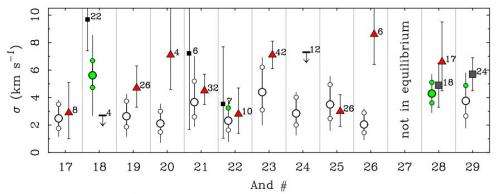MOND predicts dwarf galaxy feature prior to observations

A modified law of gravity correctly predicted, in advance of the observations, the velocity dispersion—the average speed of stars within a galaxy relative to each other—in 10 dwarf satellite galaxies of the Milky Way's giant neighbor Andromeda.
The relatively large velocity dispersions observed in these types of dwarf galaxies is usually attributed to dark matter. Yet predictions made using the alternative hypothesis Modified Newtonian Dynamics (MOND) succeeded in anticipating the observations.
Stacy McGaugh, professor of astronomy at Case Western Reserve, and Mordehai Milgrom, the father of MOND and professor of physics at Weizmann Institute in Israel, report their findings, which have been accepted for publication by the Astrophysical Journal, in a preprint online: http://arxiv.org/abs/1308.5894.
The researchers tested MOND on quasi-spherical, very low-surface brightness galaxies that are satellites of Andromeda. In the cosmic scale, they are among the smallest galaxies, containing only a few hundred thousand stars. But with conventional gravity, they are inferred to contain huge amounts of dark matter.
"Most scientists are more comfortable with the dark matter interpretation," McGaugh said. "But we need to understand why MOND succeeds with these predictions. We don't even know how to make this prediction with dark matter."
While this study is very specific, it's part of a broader effort to understand how the universe, the Milky Way and Earth formed and what it's all made of. This informs human understanding of our place in the universe, McGaugh said. Such issues have been of such importance that they've changed religion and philosophy over the centuries, sometimes sending people to be burnt at the stake.
"At stake now is whether the universe is predominantly made of an invisible substance that persistently eludes detection in the laboratory, or whether we are obliged to modify one of our most fundamental theories, the law of gravity," McGaugh continued.
The MOND hypothesis says that Newton's force law must be tweaked at low acceleration—11 orders of magnitude lower than what we feel on the surface of the Earth. Acceleration above that threshold is linearly proportional to the force of gravity—as Newton's law says—but below the threshold, no. At these tiny accelerations, the modified force law resolves the mass discrepancy.
The paper's calculations using MOND also reveal subtle differences in the gravity fields of dwarfs near and far from the host galaxy Andromeda. The gravity fields of dwarfs far from the host appear to be dominated by stars within the dwarf, while the gravity fields of dwarfs close to the host appear to be dominated by the host. No such distinction is expected with dark matter.
"The influence of the host galaxy may provide a test to distinguish between dark matter and MOND," McGaugh says. "Dark matter provides a cocoon for the dwarfs, protecting the stars from tidal influence by the host galaxy. With MOND, the influence of the host is more pronounced."
In a comparison of the predictions calculated using MOND with observations of pairs of similar dwarfs, "the data appears to show MOND's prediction for the influence of the host, but it's fairly subtle," McGaugh said. MOND's predictions of the velocity dispersion were less subtle. These predictions were "really bang on," McGaugh said.
The finding bolsters the case McGaugh and Milgrom made for MOND's effectiveness in predicting properties in dwarf galaxies in a paper published earlier this year. In that paper, they successfully predicted the velocity dispersion in 17 of the galaxies.
Journal information: Astrophysical Journal
Provided by Case Western Reserve University

















